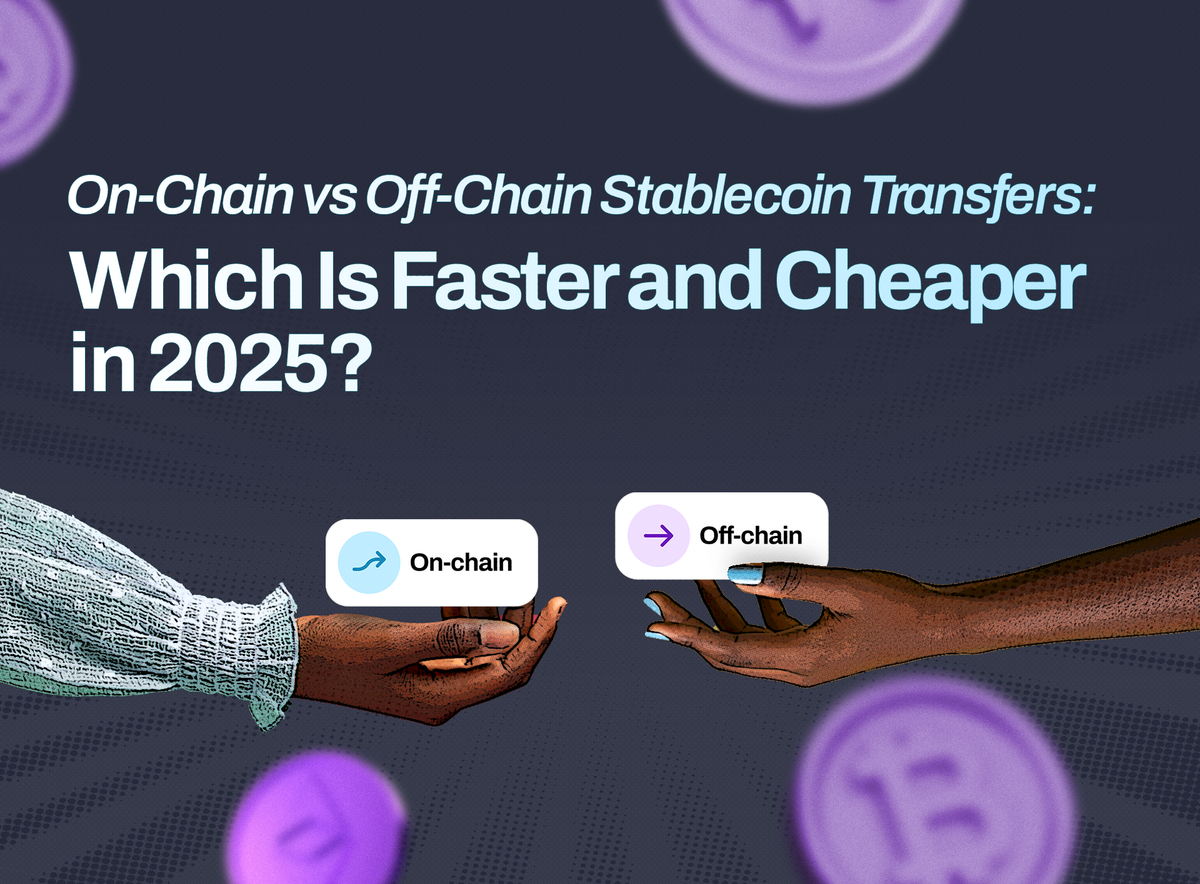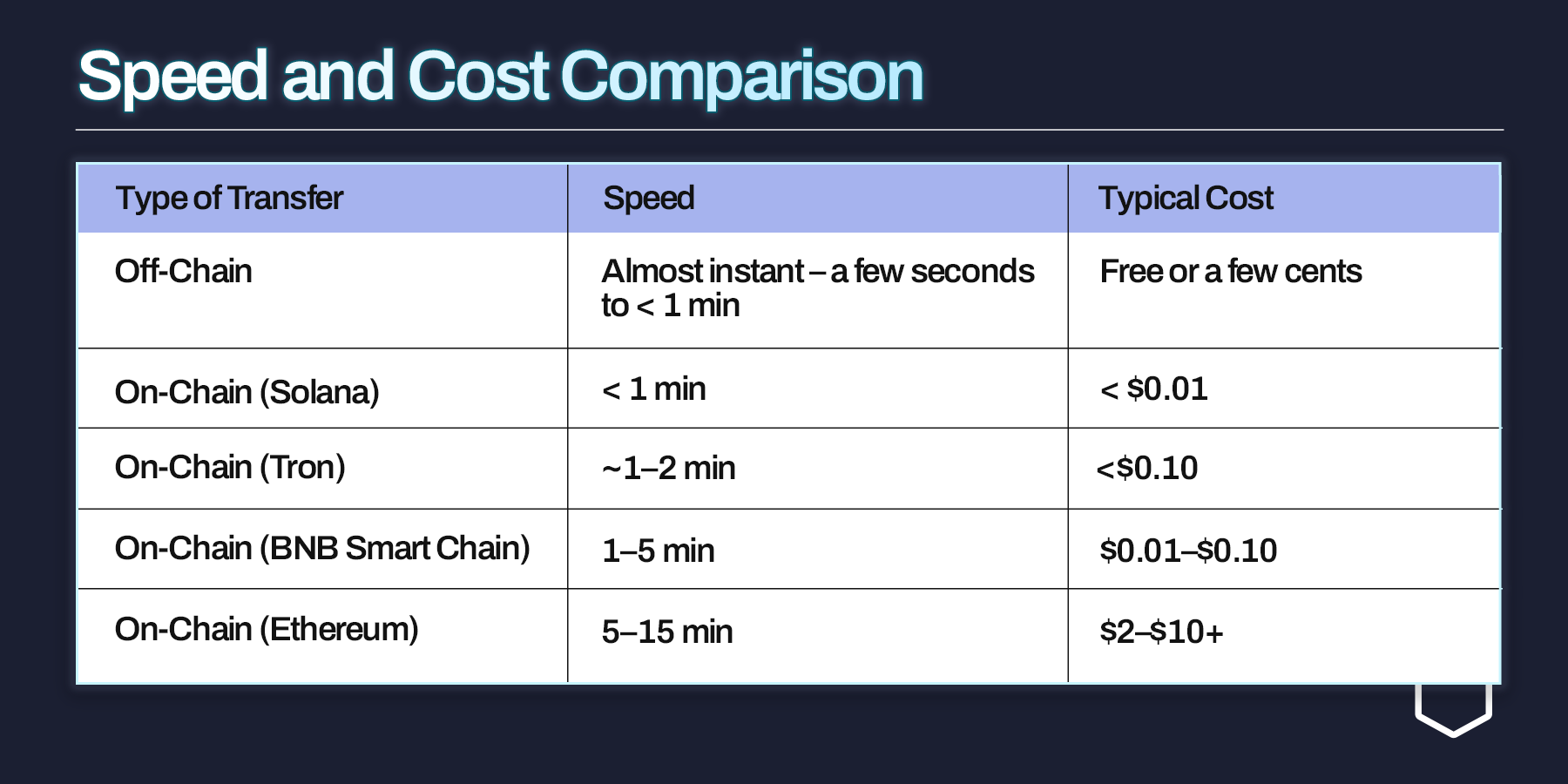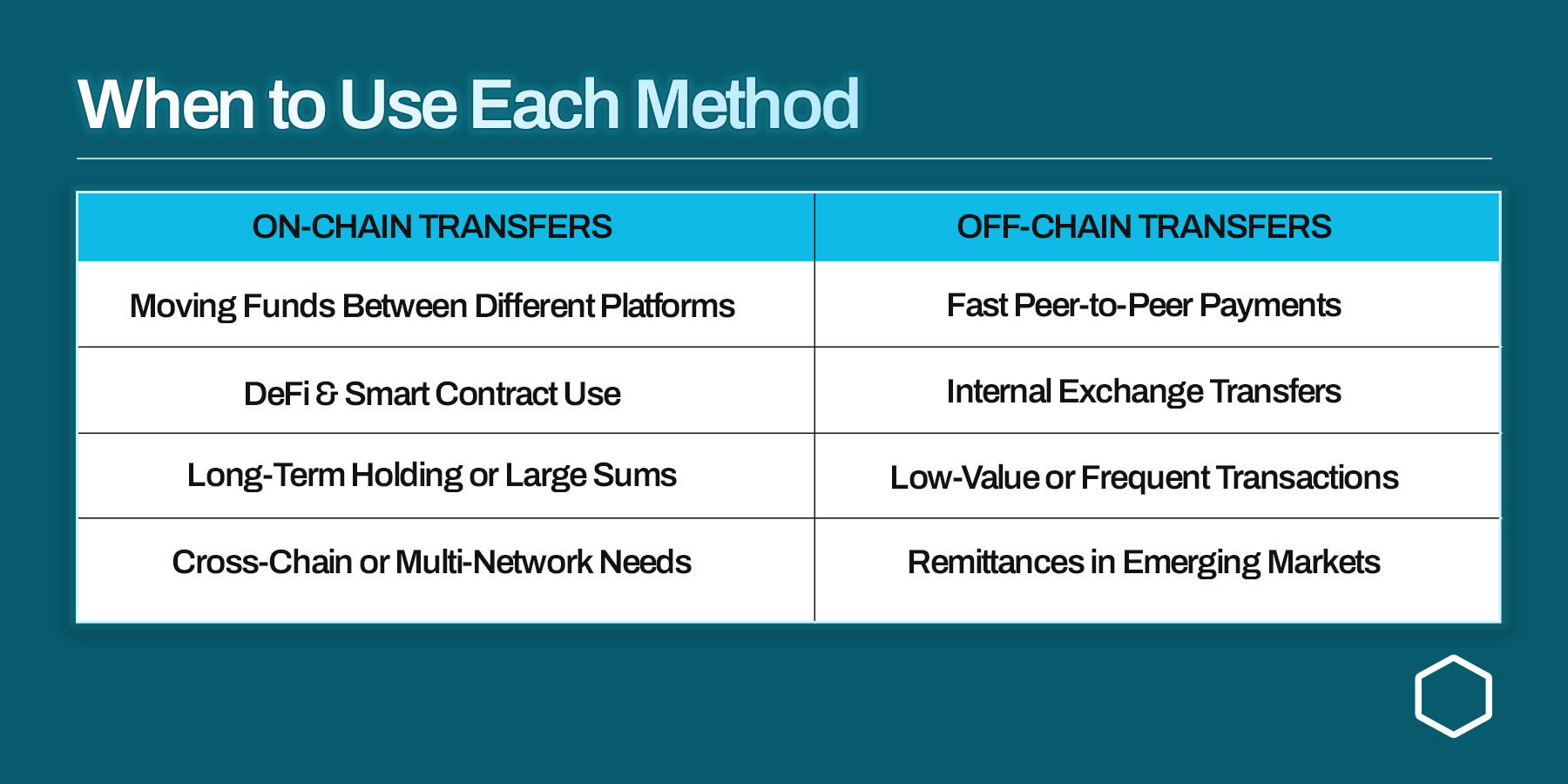On-Chain vs Off-Chain Stablecoin Transfers: Which Is Faster and Cheaper in 2025?
Discover whether on-chain or off-chain stablecoin transfers are faster and cheaper in 2025. Learn the pros, cons, fees, and best methods to move USDT, USDC, and more.

Table of Contents
- What Are On-Chain Stablecoin Transfers?
- What Are Off-Chain Stablecoin Transfers?
- Speed Comparison: Which Is Faster?
- Cost Comparison: Which Is Cheaper?
- Security & Trust Factors
- When to Use Each Method
- Obiex Edge: Faster, Cheaper Off-Chain Transfers
- How to Send USDT/USDC Off-Chain on Obiex
- To Recap
- FAQs
What Are On-Chain Stablecoin Transfers?
An on-chain stablecoin transfer is a transaction that happens directly on a public blockchain network such as Ethereum, Tron, Solana, or BNB Smart Chain.
When you send a stablecoin (USDT or USDC) on-chain, every step of the transfer is permanently recorded on that blockchain’s ledger.
How an On-Chain Transfer Works
1. Create the Transaction:
You (the sender) use a crypto wallet or exchange to enter the recipient’s wallet address and the amount of stablecoin you want to send.
2. Pay a Network Fee (Gas Fee):
To get your transaction processed, you must include a network fee, often called a gas fee. This fee pays blockchain validators or miners to confirm and secure the transfer.
3. Blockchain Validation:
The network collects pending transactions into a “block.” Validators check that you have enough funds and that the transaction follows network rules.
4. Final Confirmation:
Once added to the blockchain, your transaction receives confirmations (several new blocks built after yours). After a few confirmations, the transaction is permanent and cannot be reversed.
Key Advantages
- High Security:Every on-chain transfer is protected by the blockchain’s consensus mechanism. Once confirmed, it is extremely difficult to alter or cancel.
- Transparency:Anyone can verify the transfer using a block explorer such as Etherscan (for Ethereum) or Tronscan (for Tron). This is useful for auditing or proving that payment was made.
- Interoperability:On-chain USDT or USDC can be sent to any wallet or platform that supports the same blockchain. The recipient doesn’t need an account on a specific exchange.
Drawbacks to Consider
- Fees Can Vary:Network fees depend on blockchain activity. For example, the average Ethereum transaction fee is around US$0.45, but sending USDT (ERC-20) can cost several dollars during busy times.
By contrast, Tron (TRC-20) often charges just fractions of a cent, and Solana transactions are typically under a penny.
- Speed Depends on the Network: Transfer time is tied to block production:
- Ethereum: 5–15 minutes if the network is congested.
- Tron: roughly 1–2 minutes.
- Solana: usually less than a minute.
- Irreversible Once Sent:If you mistype the recipient’s address, there’s no “undo.” Funds sent to the wrong address are almost always lost.
What Are Off-Chain Stablecoin Transfers?
An off-chain stablecoin transfer is a movement of USDT, USDC, or another stablecoin that does not touch the public blockchain at all.
Instead of broadcasting a transaction to Ethereum, Tron, Solana, or any other network, the transfer happens inside a single platform’s own database or ledger.
How an Off-Chain Transfer Works
1. Sender and Receiver Use the Same Service:
Both people have accounts on the same exchange, wallet app, or payment platform (for example, two Obiex users).
2. Balance Adjustment Inside the Platform:
The platform simply subtracts the amount from the sender’s internal balance and adds it to the recipient’s balance in its own system.
3. Instant Confirmation:
Because no blockchain miners or validators are involved, the transfer is final the moment the platform updates its records, usually a few seconds.
Key Advantages
- Very Fast:With no need to wait for blockchain confirmations, transfers typically complete almost instantly.
- Low or Zero Fees:Since there are no blockchain gas costs, platforms often charge no fee or just a tiny service fee.For example, Obiex-to-Obiex USDT or USDC transfers are free.
- No Network Congestion:Traffic spikes on Ethereum or Tron do not affect the speed or cost.
Limitations to Know
- Same Platform Requirement:Both sender and receiver must have accounts on the same exchange or wallet service.If the recipient uses a different platform, you must use an on-chain transfer.
- Trust in the Platform:You rely on the platform’s security and bookkeeping. If it experiences a hack or mismanages funds, you could face delays or risk.
- Withdrawal Still Requires On-Chain Fees:If the recipient later wants to move funds out to a personal wallet or a different exchange, a normal on-chain transaction (and network fee) will apply.
Speed Comparison: Which Is Faster?
Off-Chain Transfers: Almost Instant
- Typical Time: A few seconds to under 1 minute
- Why So Fast: The transfer never leaves the platform. The service simply updates its internal ledger.
- Effect of Network Congestion: None, because the blockchain is not involved.
On-Chain Transfers: Depends on the Blockchain
On-chain speed varies by network because each blockchain has its own block production time and level of congestion.
Key insight: Off-chain is almost always faster if the sender and receiver are on the same platform. Among blockchains, newer high-throughput chains (Solana, Tron) are much faster than older ones (Ethereum) for stablecoin transfers.
Cost Comparison: Which Is Cheaper?
Off-Chain Transfers: Often Free
- Typical Fee: $0.00 or a few cents at most
- Reason: The transfer never touches the blockchain, so there’s no gas fee.
- Example: Obiex-to-Obiex USDT or USDC transfers cost zero. The platform just updates its internal ledger.
This makes off-chain the cheapest option whenever both sender and recipient are on the same platform.
On-Chain Transfers: Fees Vary by Network
On-chain transactions require a network fee (gas), which pays blockchain validators.
The exact cost depends on the blockchain’s design and how busy it is.

Security & Trust Factors
When to Use Each Method
1. When On-Chain Transfers Make Sense:
On-chain transfers are best when you need decentralisation, transparency, or platform flexibility.
- Moving Funds Between Different Platforms: If you’re sending USDT from your private wallet to a friend’s wallet on a different exchange (e.g., from a self-custody wallet to a Binance account), the blockchain is the only bridge.
- DeFi & Smart Contract Use: Activities like staking, lending, or using decentralised exchanges require on-chain interaction.
- Long-Term Holding or Large Sums: Keeping funds in a self-custody wallet gives you full control without relying on a third party.
- Cross-Chain or Multi-Network Needs: Want to move USDC from Ethereum to Solana via a bridge? That’s an on-chain job.
2. When Off-Chain Transfers Shine:
Off-chain transfers are ideal when speed and cost savings are your top priorities, especially if both parties use the same platform.
- Fast Peer-to-Peer Payments: Splitting rent, paying a freelancer, or sending pocket money to family across borders.
- Internal Exchange Transfers: Moving USDC between your own trading accounts or from your Obiex wallet to another user’s Obiex wallet.
- Low-Value or Frequent Transactions: Sending $10 or $50 multiple times a day without worrying about gas fees.
- Remittances in Emerging Markets: Off-chain transfers skip congested blockchains, giving near-instant settlement and no network charges.

Obiex Edge: Faster, Cheaper Off-Chain Transfers
1. Instant Obiex-to-Obiex Transfers:
- Speed: Transfers between two Obiex accounts settle in seconds, not minutes.
- No Network Confirmations: Because the transaction stays on Obiex’s internal ledger, it never waits for Ethereum, Tron, or Solana block confirmations.
2. Zero Network Fees:
On Ethereum, network fees can still range from $2–$10 depending on activity.On the Obiex platform, you pay nothing to send stablecoins to another Obiex user.
This makes micro-payments practical. You can send $5 or $10 multiple times a day without worrying about gas fees eating into your funds.
3. Multi-Stablecoin Support:
Obiex supports major stablecoins like USDT, USDC, and BUSD across multiple networks (Ethereum, Tron, Solana).
You can hold or swap them instantly before sending. No external wallet juggling required.
4. Simple, 3-Click Sending Process:
Sending USDT or USDC off-chain on Obiex is straightforward:
- Log In: Open your Obiex account on the app or website.
- Select Recipient: Enter the recipient’s Obiex username.
- Send: Confirm the amount and tap “Send.”
That’s it! Your stablecoins arrive almost instantly.
5. Secure by Design:
- Custody & Cold Storage: Most funds are kept offline to prevent hacks.
- Two-Factor Authentication (2FA): Adds an extra layer of protection.
- Regular Audits & Proof of Reserves: Increases user confidence.
How to Send USDT/USDC Off-Chain on Obiex
Step 1: Log In to Your Obiex Account
Open the Obiex website or mobile app and log in with your credentials.
Step 2: Select “Withdraw” on the Dashboard
From your dashboard, click the “Withdraw” button. This may seem counterintuitive, but Obiex treats off-chain transfers as a type of withdrawal from your internal balance.
Step 3: Choose Your Stablecoin
Select the stablecoin you want to send, USDT or USDC.
Step 4: Select “Send to Obiex Username”
Instead of sending to an external wallet, choose the “Send to Obiex Username” option. This ensures your transfer stays off-chain and avoids any network fees.
Step 5: Input the Recipient’s Username
Enter the Obiex username of the recipient. Make sure the recipient also has an Obiex account to receive the funds instantly.
Step 6: Complete the Transaction
Double-check the details, confirm the amount, and click “Send”. Your funds arrive almost instantly in the recipient’s Obiex wallet. No network fees are charged.
To Recap
- On-chain transfers are necessary when sending outside your platform, using smart contracts, or dealing with external wallets. They are secure and transparent, but can be slower and cost more, especially on networks like Ethereum.
- Off-chain transfers (internal transfers on the same platform) are almost always faster (seconds), cheaper (often free or small fee), and ideal when both sender and recipient are using the same service.
👉Want to avoid unnecessary fees and delays? Start using Obiex.
FAQs
Q1. What is the difference between on-chain and off-chain stablecoin transfers?
On-chain transfers are recorded on the blockchain. Off-chain transfers happen inside a platform.
Q1. Which stablecoin network has the lowest fees in 2025?
Networks like Solana and Tron (TRC-20) are among the cheapest.
Q3. Are off-chain transfers safe?
Yes, generally safe when using reputable platforms. You depend on the platform’s custody, internal security, and compliance.
Q4. Can I send USDT from Obiex to another exchange off-chain?
Only if the other exchange supports internal transfers (off-chain) to/from Obiex and both platforms agree. Most often, sending to another exchange requires on-chain transfer (you send from your Obiex wallet to external address).
Q5. How long does an on-chain USDT transfer take on Ethereum vs Tron?
On Ethereum (ERC-20), usually 5-15 minutes . On Tron (TRC-20), typically around 1-2 minutes under normal conditions.
Q6. Can I switch from off-chain to on-chain transfer after sending?
No. Once you send a stablecoin off-chain within a platform like Obiex, the transfer stays internal. To move funds on-chain, you must perform a separate on-chain withdrawal to an external wallet.
Q7. Are there limits on off-chain stablecoin transfers on Obiex?
Yes. Obiex sets minimum and maximum transfer limits for off-chain transactions. These limits vary by account verification level and the stablecoin being sent.
Q8. Can off-chain transfers fail or get reversed?
Off-chain transfers on Obiex are almost always instant and final. Reversals are generally not possible, but Obiex support can help in rare cases of technical errors or incorrect usernames.
Q9. Does sending USDT off-chain affect the stablecoin’s price?
No. Off-chain transfers do not enter the public blockchain and therefore do not incur trading fees or affect market prices.
Q10. Can I send off-chain stablecoins internationally without currency conversion?
Yes. Since off-chain transfers remain within Obiex, you can send USDT or USDC across countries without converting to local currency.
Disclaimer: This article was written to provide guidance and understanding. It is not an exhaustive article and should not be taken as financial advice. Obiex will not be held liable for your investment decisions.
